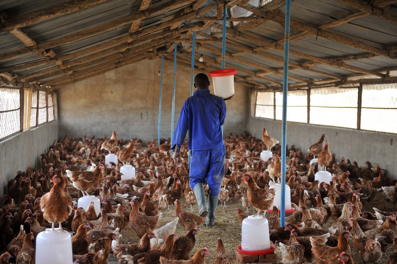 Cleanzine: your weekly cleaning and hygiene industry newsletter 11th April 2024 Issue no. 1109
Cleanzine: your weekly cleaning and hygiene industry newsletter 11th April 2024 Issue no. 1109
Your industry news - first
The original and best - for over 20 years!
We strongly recommend viewing Cleanzine full size in your web browser. Click our masthead above to visit our website version.
Worries rise over outbreaks of Avian Flu in West Africa
 Fears are growing that without timely intervention to stem outbreaks of the highly virulent Avian Flu virus H5N1 across West Africa, further spread across the region and beyond is inevitable.
Fears are growing that without timely intervention to stem outbreaks of the highly virulent Avian Flu virus H5N1 across West Africa, further spread across the region and beyond is inevitable.
The Food & Agriculture Organisation of the United Nations is calling for $20 million for prevention and response activities that will include infection control programmes and behavioural changes such as the incorporation of enhanced hygiene routines.
The FAO's appeal for $20 million for prevention and response foresees bolstering weak veterinary systems, improving the capabilities of local laboratories and putting FAO specialists on the ground in affected and at-risk countries. In the countries that have experienced outbreaks, response interventions will include destruction of infected and exposed poultry, disinfection of premises and markets and the safe disposal of dead birds.
Veterinary officers will be encouraged to use infection control measures and basic techniques such as 'trace-forward' - which looks at where infected animals have been sold or moved to - and 'trace backward' - examining where infected animals were purchased or where they came from - to find sources with the ultimate goal of halting continuous virus introduction or further spread.
The agency believes that although quality vaccines are available, the vaccination strategy to be implemented poses certain challenges in some countries and there is always a risk of creating a false sense of security by assuming that the administration of a dose of vaccine will resolve all threats. Instead, behavioural changes - including enhanced hygiene routines, good poultry production, and safe transportation practices of healthy animals - ought to be at the heart of prevention plans, it argues.
Collaborating with the private sector, particularly poultry and rural or market associations, is crucial to getting the message out to producers and sellers.
Poultry production has grown steadily in West Africa over the last 10 years, with some countries, like Cote d'Ivoire, seeing production soar by over 60 percent since 2006. But regulatory systems have not grown to deal effectively with this increase in production and there is an acute need to make the market chains safer - from production to transporter to seller. At a regional level, these value chains can be across borders and thus require stronger customs controls and greater compliance with product safety norms.
In addition to working with national veterinary offices, the FAO recommends that good preparedness plans include close coordination with security forces - military and police - as well as with provincial government leaders, the World Health Organisation and regional bodies such as ECOWAS (the Economic Community of West African States), to better control outbreaks and prevent the virus from spreading across the region of 330 million people.
"We're looking at a disease - H5N1 - that has already spread to five countries in six months. We have to make a concerted effort to stop it in its tracks and we have to do it now," says Juan Lubroth, chief of FAO's Animal Health Service Division. "Based on what we do know, there is a real risk of further virus spread. Urgent action is needed to strengthen veterinary investigation and reporting systems in the region and tackle the disease at the root, before there is a spillover to humans."
The FAO's concern follows outbreaks of the virus in poultry farms, markets and family holdings in Nigeria, Burkina Faso, Niger, Cote d'Ivoire and Ghana. The outbreak comes as countries across West Africa are still recovering from - and in some cases still battling, Ebola.
Previous strains of the virus - known to be highly virulent to poultry and capable of causing illness and fatalities in humans - have been circulating in Asia since the early 2000s and in Egypt for almost 10 years. The H5N1 strain has caused the death of tens of millions of poultry and losses of tens of billions of dollars.
While the first incursion of the H5N1 in West Africa occurred in 2006 it was eliminated by 2008. In late 2014, however, the virus was re-introduced in Nigeria, where it spread rapidly in the following three months - to date more than 1.6 million birds have been culled or have died from the virus.
Because the disease can be transmitted to humans and is considered highly lethal, the FAO is working closely with the World Health Organisation on country assessments, contingency plans, offering technical assistance and investigating potential flu cases and the source of infection.
The FAO assessment missions to Benin, Cameroon, Mali and Togo - undertaken in collaboration with the World Organisation for Animal Health, the African Union, and in some cases with the World Bank - have not identified cases of H5N1 in poultry, but these countries and other countries in the Sub-Region need to ensure that prevention and preparedness measures are in place.
30th July 2015







